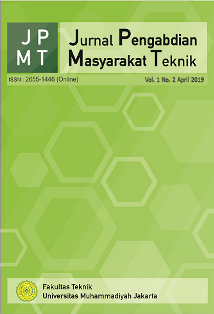PEMBUATAN TEMPAT ALAT TULIS KANTOR BERBAHAN DASAR FIBER MESOCARP PALM OIL (FMPO)
DOI:
https://doi.org/10.24853/jpmt.2.2.65-70Keywords:
Alat Tulis Kantor, Limbah, Fiber MesocarpAbstract
Alat Tulis Kantor merupakan peralatan tulis yang diperlukan oleh setiap orang untuk melakukan pencatatan secara manual untuk proses administrasi dan dokumentasi pekerjaan. Alat Tulis Kantor yang berdimensi kecil dan realtif banyak, maka diperlukan alat penyimpanan yang mudah, murah, dan tahan benturan. Serat buah kelapa sawit (Fiber Mesocarf Palm Oil) merupakan bahan baku yang mudah dibentuk sesuai yang diingkan dengan menambahkan perekat. Fiber Mesocarp dapat dibentuk menjadi tempat Alat Tulis Kantor dan memiliki value dari Fiber Mesocarp yang merupakan limbah padat hasil produksi Pabrik Minyak Kelapa Sawit (PMKS).References
Arahman, N., Erika, C., & Putra, A. Pemurnian Minyak Kelapa Sawit Menggunakan Membran Serat Berongga. agriTECH, 33(1).
Aziz, M. R., Siregar, A. L., Rantawi, A. B., & Rahardja, I. B. (2019). Pengaruh Jenis Perekat Pada Briket Cangkang Kelapa Sawit Terhadap Waktu Bakar. Prosiding Semnastek.
Chieng, B. W., Lee, S. H., Ibrahim, N. A., Then, Y. Y., & Loo, Y. Y. (2017). Isolation and characterization of cellulose nanocrystals from oil palm mesocarp fiber. Polymers, 9(8), 355.
Erivianto, D., & Notosudjono, D. (2016). Penggunaan Limbah Padat Kelapa Sawit Untuk Menghasilkan Tenaga Listrik Pada Existing Boiler. SAINSTECH, 26(2).
Febijanto, I. (2007). Potensi Biomasa Indonesia Sebagai Bahan Bakar Pengganti Energi Fosil. Jurnal Sains dan Teknologi Indonesia, 9(2).
Hendrawati, T. Y., Siswahyu, A., & Ramadhan, A. I. (2017). Pre-Feasibility Study of Bioavtur Production with HEFA Process In Indonesia. International Journal of Scientific & Technology Research, 6(04).
Martynis, M., Sundari, E., & Sari, E. (2012). Pembuatan biobriket dari limbah cangkang kakao. Jurnal Litbang Industri, 2(1), 35-41.
Maruli Pardamean, Q. I. A. (2012). Sukses Membuka Kebun dan Pabrik Kelapa Sawit. Penebar Swadaya.
Karina, M. (2016). Peranan 3r (Reuse, Reduce, Recycle) Dalam Menciptakan Masyarakat Yang Berwawasan Daur Ulang Di Jepang (Doctoral dissertation, Universitas Darma Persada).
Parandoush, P., & Lin, D. (2017). A review on additive manufacturing of polymer-fiber composites. Composite Structures, 182, 36-53.
Rahardja, I. B., & Ramadhan, A. I. (2019). Pemanfaatan Daun Nangka Kering Sebagai Tempat Alat Tulis Kantor (ATK). Jurnal Pengabdian Masyarakat Teknik, 2(1), 1-6.
Rahardja, I. B., Rikman, R., & Ramadhan, A. I. (2018). Analysis of Heat Transfer of Fiber Mesocarp of Palm Oil (Elaeis Guineensis Jacq) as Roof Building. Journal of Applied Sciences and Advanced Technology, 1(1), 1-8.
Rahardja, I. B., Dinary, R., & Ramadhan, A. I. (2019). Crystal Exergy Value (Wax) Crude Palm Oil (CPO) Influence Based On The Mixed Type. Journal of Applied Sciences and Advanced Technology, 1(3), 91-98.
Rahardja, I. B., Mahfud, A., Dermawan, Y., Rantawi, A. B., Lestari, I., Siregar, A. L., & Ramadhan, A. I. (2019, December). Pelatihan Pembuatan Lilin Untuk Penerangan Rumah Tangga Menggunakan Bahan Dasar Crude Palm Oil (CPO). In Prosiding Seminar Nasional Pengabdian Masyarakat LPPM UMJ.
Raharjo, S. (2012). Analisis Thermogravimetry Limbah Padat Kelapa Sawit Dan Potensi Konversinya Menjadi Gas Bakar. Jurnal Teknik Lingkungan UNAND, 9(2), 115-120.
Subiyanto, B., Rasyid, E., Gopar, M., & Firmanti, A. (2018). Veneer and thin plywood overlaid for quality improvement of particleboard made of palm oil empty fruit bunches (EFB). Jurnal Ilmu dan Teknologi Kayu Tropis, 6(1), 17-20.
Downloads
Published
Issue
Section
License
Authors who publish with this journal agree to the following terms:
- Authors retain copyright and grant the journal right of first publication with the work simultaneously licensed under a Creative Commons Attribution License that allows others to share the work with an acknowledgement of the work's authorship and initial publication in this journal.
- Authors are able to enter into separate, additional contractual arrangements for the non-exclusive distribution of the journal's published version of the work (e.g., post it to an institutional repository or publish it in a book), with an acknowledgement of its initial publication in this journal.
- Authors are permitted and encouraged to post their work online (e.g., in institutional repositories or on their website) prior to and during the submission process, as it can lead to productive exchanges, as well as earlier and greater citation of published work (See The Effect of Open Access).






